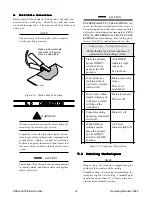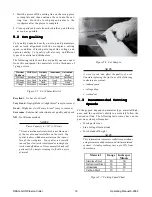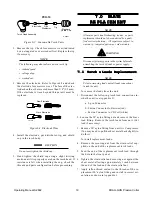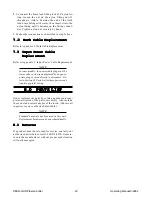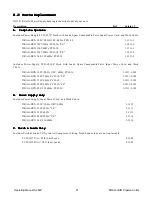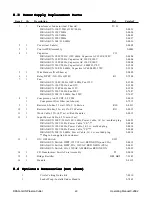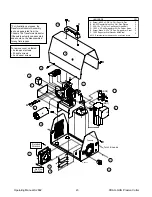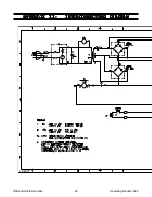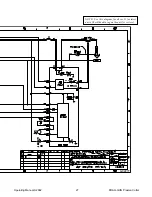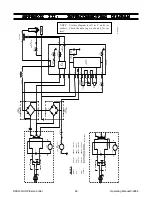
Operating Manual 0-2682
17
DRAG-GUN Plasma Cutter
5.4 Common Cutting Faults
5.4 Common Cutting Faults
5.4 Common Cutting Faults
5.4 Common Cutting Faults
5.4 Common Cutting Faults
A. Insufficient Penetration
. Insufficient Penetration
. Insufficient Penetration
. Insufficient Penetration
. Insufficient Penetration
a. Cutting speed too fast
b. Torch tilted too much
c. Metal too thick
d. Worn torch parts
B. Main Arc Extinguishes
B. Main Arc Extinguishes
B. Main Arc Extinguishes
B. Main Arc Extinguishes
B. Main Arc Extinguishes
a. Cutting speed too slow
b. Torch standoff too high from workpiece
c. Work cable disconnected
d. Worn torch parts
C. Excessive Dross Formation
C. Excessive Dross Formation
C. Excessive Dross Formation
C. Excessive Dross Formation
C. Excessive Dross Formation
a. Cutting speed too slow
b. Torch standoff too high from workpiece
c. Worn torch parts
D. Short Torch Parts Life
D. Short Torch Parts Life
D. Short Torch Parts Life
D. Short Torch Parts Life
D. Short Torch Parts Life
a. Exceeding system capability (material too thick)
b. Excessive pilot arc time
c. Improperly assembled torch
d. Inadequate air supply (check filter on compressor)
e. Faulty air compressor
5.5 Common Operating
5.5 Common Operating
5.5 Common Operating
5.5 Common Operating
5.5 Common Operating
Problems
Problems
Problems
Problems
Problems
Getting used to the way the system sounds and feels while
it is operating properly will help to determine the nature
of problems if they should arise.
A. Compressor Related
A. Compressor Related
A. Compressor Related
A. Compressor Related
A. Compressor Related
If the unit is cold, the air compressor may not start up or
may run sluggishly. Most likely, when the torch switch is
depressed, the unit will click once and nothing more will
happen. Let the unit warm up to room temperature, ap-
proximately over 50° F (10° C) and try again.
If the air filter on the compressor becomes clogged, the
compressor may sound more labored, cut speed and qual-
ity will be reduced, and the arc may have a more green
color. The air filter element can be cleaned - remove it,
blow air through it, and reinstall it.
WARNING
Do not operate unit without filter installed.
B. Power Source Related
B. Power Source Related
B. Power Source Related
B. Power Source Related
B. Power Source Related
If the main power service available fluctuates, pilot and
cut performance will be degraded. In some cases, the main
power service circuit breaker may open during use. Some
things that will help:
• Use a service fused or circuit breaker for the correct
amps. (refer to subsection 4.0-D)
• Use heavy gauge extension cords (Refer to subsec-
tion 4.0-D for extension cord lengths).
• Use as short an extension cord as possible.
• Try different outlets on different branch circuits. Use
the one that gives the strongest pilot.
C. Power Supply/Torch Related
C. Power Supply/Torch Related
C. Power Supply/Torch Related
C. Power Supply/Torch Related
C. Power Supply/Torch Related
In some instances, the service may be good but when the
torch switch is pressed the compressor comes on but there
is no pilot. You may need to try several times before the
torch fires.
If the torch does not fire (no pilot arc) soon after the torch
switch is activated, try releasing the torch switch and let-
ting the leads bleed down before trying again. The torch
pilots best if started under low air pressure. This helps
because the torch fires at a lower voltage with lower air
pressure at the torch.
D. Cutting Related
D. Cutting Related
D. Cutting Related
D. Cutting Related
D. Cutting Related
1. Piloting
One of the features of this plasma cutter is the con-
stant DC pilot. This means the plasma arc is always
“on”- either as a pilot arc, or a cutting arc, resulting in
a very smooth, forgiving system. This also means that
the torch tip will wear fairly rapidly if you pilot for
an extended time or cut with too great a standoff (es-
sentially switching from a transferred cutting arc back
to the constant DC pilot arc).
The best way to prevent this is to pilot for no more
than 5 seconds at a time (or start with the torch in
contact with the material) and “drag cut”, that is, hold
the tip in direct contact with the material to be cut.
For some materials, holding a slight standoff (1/16")
may provide a better cut.
Summary of Contents for Drag-gun
Page 2: ......












